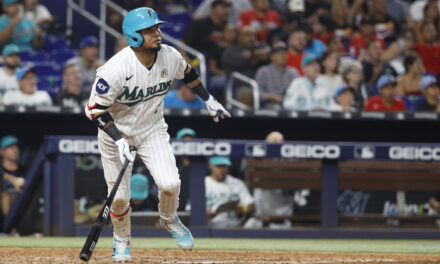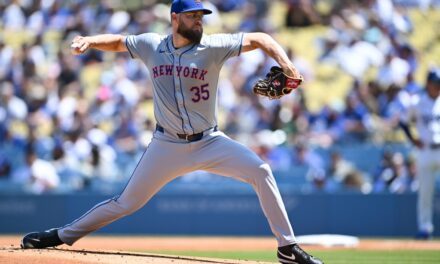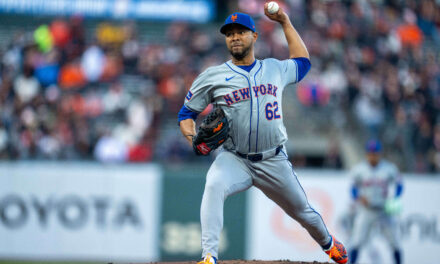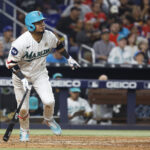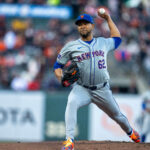
I remember the game because it was on my birthday, September 27. A meaningless game but as the season was almost over I felt the need to absorb what precious little baseball was left. I wanted to watch Rafael Montero’s outing because I’d noticed a change in him over his previous few starts. He was challenging hitters more and looking like the prospect we were led to believe was (as recently as May of 2014) ahead of Jacob deGrom.
I missed the first inning because my wife took me out to an all you can eat sushi place, which is a sort of a culinary oxymoron — sushi is neat and diminutive by nature, not something to gorge on. I mean if you’re going to eat wheelbarrow amounts of food why make it tiny? It would make more sense to serve one giant sushi slab, like an entire 34 inch side of salmon slapped over a three pound mound of rice, it would save on labor. Anyway, Montero had a shutout going and seemed in complete control. Unfortunately the Mets offense had yet again dematerialized into a barely audible entity like little Heather O’Rourke in Poltergeist, mustering only two disembodied hits over the first eight innings off of ex-Twin Sam Deduno.
I’d been following Montero’s progress for a while because he’s kind of an oddball case. Signed as a 19 year old out of the Dominican, he was not really a late bloomer as he hadn’t played much at all until his late teens. Montero came to the Mets about as raw as a chunk of yellowfin tuna but with some exceptional condiments nevertheless, namely a live arm and otherworldly command. The thing that has always impressed me about Montero is the zip he gets on his fastball from a windup that looks like a dad tossing a ball with his kid in the park. People talk about his meh fastball but that lazy delivery allows it to creep up on you quicker than you expect. His two seamer in particular has some heavy and late sink, and 92 – 94 is plenty of mustard if you ask me.
Montero is a work in progress for sure but there is certainly plenty to work with. His slider has some major break (although he appears to telegraph it a tad) and for the life of me I can’t figure out why he doesn’t use his changeup more, a weird pitch coming in at around 87 mph that thinks it’s a splitter. Montero has a decent arsenal but in his first few starts he was locked into straight as hell four seamers with an occasional off the plate slider worked in for good measure, not a good recipe for getting major league hitters out.
In the sixth, Dexter Fowler hit an infield single and scored on a double by Jason Castro as I started to feel the effects of way too much raw fish while thoughts of another wasted starting pitching performance flashed through my mind. Against the blech Astros no less. It would take 10 innings, an Eric Young triple and walk off blast by Duda to put this one in the books.
Lost in the walk-off festivities, however, was Montero’s performance. It made me wonder why he struggled so uncharacteristically with his command in his previous stint? You look back at his numbers and it gets even more puzzling. He had 88 innings in the PCL in 2013 where he featured a sub-3 FIP. This is a league that eats pitchers alive from the inside as if by parasitic alien larvae. Consider for a moment that per statcorner.com, through 140 games last season the PCL averaged 10.2 runs per game compared to MLB’s 8.4, now add to that a 15% bump in runs allowed particular to Cashman field in Las Vegas and you have the makings of many a pitching horror show. That didn’t seem to trouble Montero in the least as he torched the PCL in 2013 featuring a respectable 2.5 BB/9. His first few starts in 2014 in Vegas were more of the same … Then, something happened. Montero’s walks jumped dramatically. Now you’ll remember this was the kid with the insane 1.9 BB/9 in A+ ball, a kid who had already established his command in AAA. What happened?
On June 15th after just 5 pitches he was pulled from his AAA game with a strained left oblique. This after posting a 5.40 ERA and a 1.60 WHIP in the majors prior to being sent down. How long was the oblique bothering him? Was he trying to pitch through it with deGrom breathing down his neck and the understanding that 2014 was his big chance coursing through his mind? Rafael just didn’t look right in that first stint with the parent club.
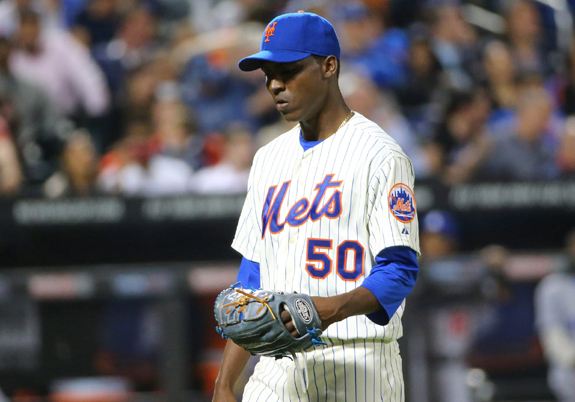
Oblique injuries are notorious for their tendency to linger, and as a control artist Montero could have conceivably been hobbled by an initial minor strain well before the injury that put him on the DL, hampering him enough to throw his command off but not enough to keep him out of games. The fact that it was his left oblique only increases the possibility that Montero may have tried to pitch through some discomfort as he is right handed. As a righty he may have also sustained the initial injury swinging the bat. The reason we all felt like the Montero we saw in his first stint in 2014 was not as advertised is because he may very well have been hurt. Was he better in his second stint because of improved confidence and exposure, or was it because the oblique injury was behind him?
If I were an opposing GM Montero is the guy I’d go after. Syndergaard is untouchable, and the Mets may very well be convinced to part with Montero given a fan base clamoring for a big trade. He’s also undervalued given his up and down performance in 2014. But trading Montero would be a huge mistake. Unlike the slew of power guys in the system, Montero is capable of dialing his velocity back and working off of his command and control. Montero is seen by the organization as an innings eater and as such they feel he needs to be better about pitching to contact, but Montero’s K rates don’t support that and the conclusion that he’s a middle of the rotation contact guy appeared to grow out of his struggles at the major league level. For the record, steamer projects significant corrections in 2015 with a K/BB ratio rising from 1.83 in 2014 to 2.85 in 2015 and his walks per 9 dropping from 4.67 in 2014 to 2.99 in 2015. Zips projects him to pitch 144 innings at a 3.61 era and a 22.6 K% … all marked improvements over his 2014. There is absolutely nothing in this kid’s history to support the sudden loss of perhaps his most prominent asset, his control, without some underlying cause. Until his 2014 season he never in his career had a BB/9 over 3.00 … which included his initial stint in AAA in 2013 where he put up a 2.54 BB/9. Same league, same home park, one year later his BB/9 balloons to 3.83? Makes no sense.
There is another consideration with Montero. Unlike many other pitching prospects he is something of a novelty in that there is very little mileage on his arm. Most young prospects, even those signed out of high school, come with many hundreds if not thousands of innings on their arms. An often cited study by the American Sports Medicine Institute found that young pitchers between the age or 9 and 14 who threw more than 100 innings in a season were 3.5 times more likely to be injured than those who threw less than 100 innings. Montero’s odometer at 19 was zero, yet he rocketed through the system and was on the brink of a major league starter’s job 4 years later. In this age where TJ surgeries are a virtual given, the projected longevity of that elbow has to be taken into account.
Montero’s upside is as high as it’s ever been in my estimation. His arsenal is outstanding, he has 4 legitimate major league offerings and impeccable, albeit unrealized (at the major league level) command. Unlike so many other young power arms he also doesn’t need to torque up every muscle and tendon in his shoulder to maximum output in order to get hitters out.
I’m convinced the oblique injury pre-dated that June 15th game when he was finally pulled, and the numbers in Vegas support this … again, Montero had already established success in one of toughest places for pitchers in the minors prior to his struggles in 2014 … and predictably we all saw a different pitcher later in the season when he’d presumably recovered. Trading him now with his value low, without giving him a chance to show what he can do, would be a risk whose rewards would be far outweighed by the potential loss of watching him revert to the control freak he’s been throughout his career, only with a different team.



